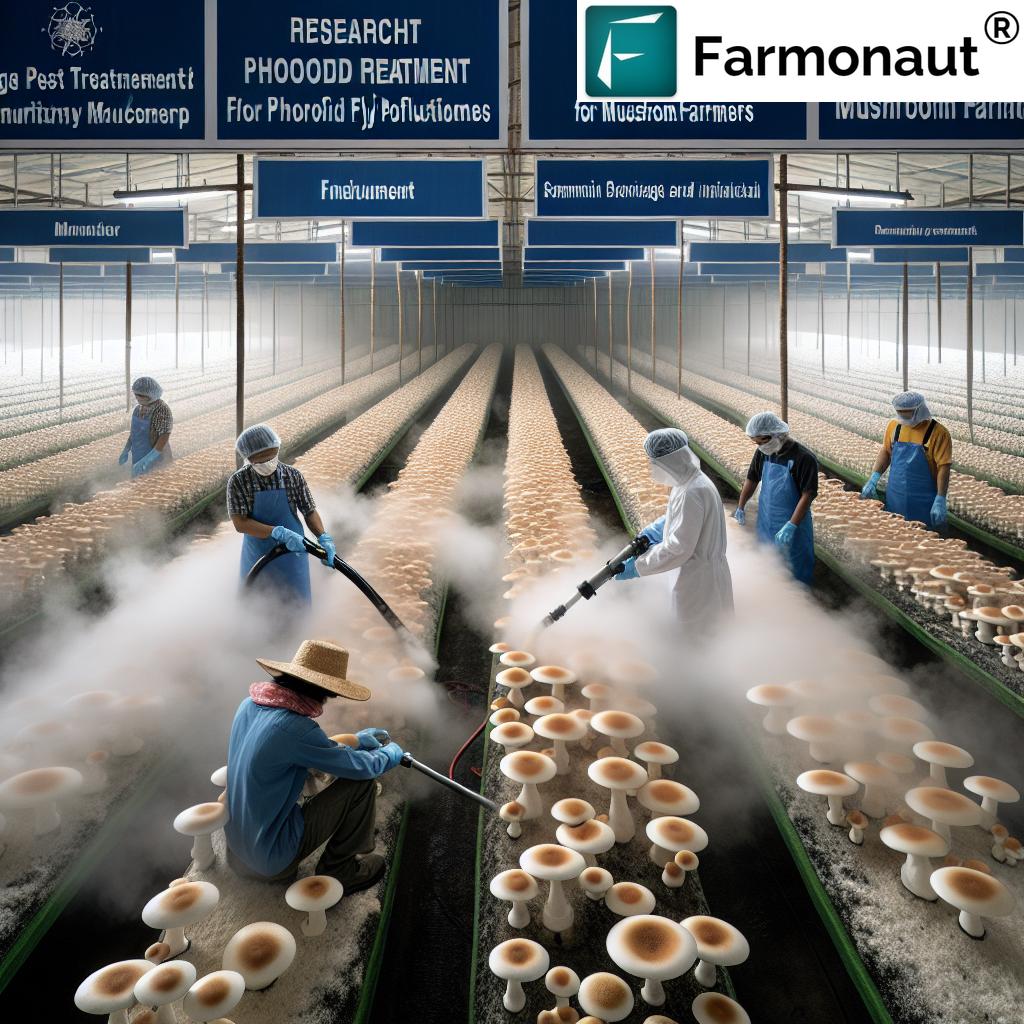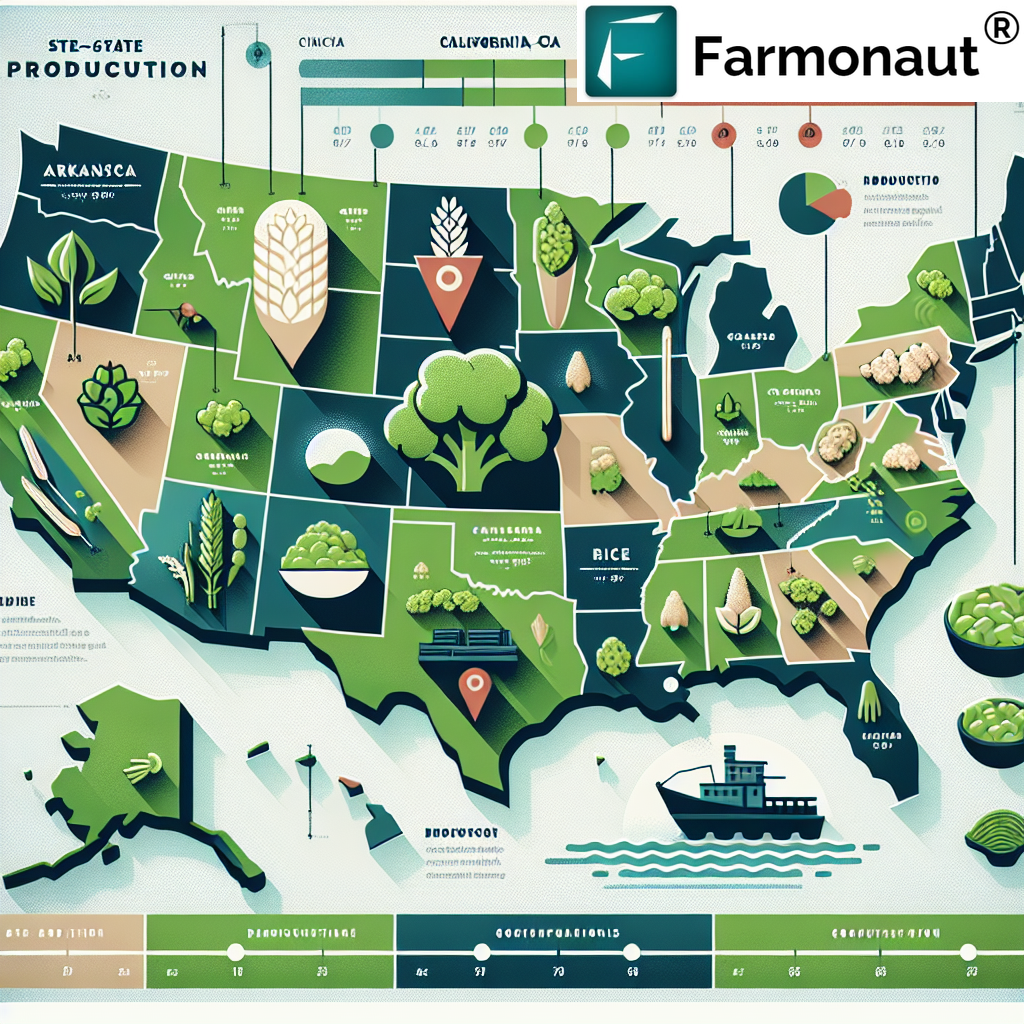Pennsylvania Quarantines Mushroom Farms for Phorid Fly: A Comprehensive Guide to Pest Control and Support
“Over 60% of Pennsylvania’s mushroom farms are under quarantine due to the rapid spread of phorid fly infestations.”
Introduction
As the leading state in the nation’s mushroom production, Pennsylvania has built a reputation for agricultural excellence—anchored by the thriving mushroom industry in Chester County. However, the dawn of 2025 has brought an unprecedented challenge: the phorid fly infestation Pennsylvania is currently facing threatens not only crop yields and economic viability but also the quality of life for communities in the region.
On January 30, 2025, the Pennsylvania Department of Agriculture issued a strict quarantine order covering mushroom farms in Kennett and New Garden Townships following the alarming spread of phorid flies (Megaselia halterata). This action marks a crucial step in addressing the dual problem of productive farm losses and growing community concerns.
In this comprehensive guide, we explore the scale and significance of the threat, dissect the newly implemented regulations, highlight the coordinated pest control strategies and support provided for affected growers, and discuss innovative technologies and future outlooks for the entire agricultural sector.
Understanding the Phorid Fly Threat in Pennsylvania’s Mushroom Farms
Phorid flies, particularly Megaselia halterata, have emerged as a formidable pest in Pennsylvania mushroom houses. These small insects thrive in the dark, humid environments found in commercial mushroom farms—conditions that support productive fungal growth but also accelerate pest infestations.
Phorid Fly Biology and Life Cycle
- Appearance: Humpbacked, dark flies, only a few millimeters long.
- Reproduction: Female flies can lay up to 50 eggs at a time (with total lifetime capability of up to 500 eggs), primarily near fresh mycelium, the foundation of mushroom growth.
- Feeding: Creamy-white larvae—up to a quarter-inch long—feed voraciously on mushrooms and fungal tissue.
- Damage: Infestations can cause up to 40% yield reduction by damaging developing mushrooms and spreading pathogens. This has major implications for crop health and economic returns.
Beyond direct crop damage, phorid flies migrate from farms, becoming a significant nuisance in residential areas. Local communities in Kennett and New Garden report swarms finding their way into homes, impacting quality of life and prompting calls for coordinated action.
“Phorid flies can lay up to 500 eggs in mushroom beds, prompting urgent pest control strategies statewide.”
Why Are Phorid Flies a Persistent Threat?
- Rapid Reproduction: High egg-laying capacity and fast larval development lead to explosive population growth.
- Environmental Adaptability: Thrive in climates and conditions designed to optimize mushroom production.
- Lifecycle Overlap: Multiple, overlapping generations allow for near-constant pressure on farms and crops.
As a result, phorid fly infestations present a duel threat: directly threatening Agricultural yields and indirectly jeopardizing the livability of neighboring communities.
Economic and Social Implications: Impact on Pennsylvania’s Mushroom Industry
Let’s evaluate the scale of the problem:
- In 2023, Pennsylvania produced 466 million pounds of agaricus mushrooms—with a farm-gate value around $531 million (pa.gov).
- Chester County is home to approximately 2,000 mushroom farms—making it the epicenter of American mushroom production (dailyvoice.com).
- The impact of phorid flies on mushroom yields can erase millions in revenue and threaten farm viability.
- Cascading effects include job losses, supply chain disruptions, and setbacks for local economies reliant on the mushroom sector.
- Affected communities experience reduced quality of life from pervasive fly populations indoors and outdoors.
Given Pennsylvania’s pivotal role in national mushroom supply, the phorid fly infestation is truly a statewide threat—demanding robust, science-driven intervention.
The Chester County Mushroom Quarantine Order: Protecting Production and Communities
To combat this relentless pest, the Pennsylvania Department of Agriculture enacted a quarantine order in January 2025—directly targeting all mushroom operations within Kennett and New Garden Townships.
Key Requirements of the Quarantine Order
-
Mandatory Steam Treatment: All growers must subject their mushroom houses to steam treatment (pasteurization) between each crop cycle. This process involves raising air and substrate temperatures to levels that:
- Eliminate adult phorid flies and larvae
- Destroy bacteria, unwanted fungi, and potential plant pathogens
- Sanitation and Prevention: Farmers must prevent the spread of any phorid fly population or contaminated material to adjacent properties or subsequent crops.
- Strict Compliance: These measures are non-negotiable and subject to inspection and enforcement.
This Chester County mushroom quarantine is designed to shield the industry from collapse—by containing the infestation and preventing spread to not yet affected farms.
Steam Treatment for Phorid Flies and Mushroom Farm Pest Control Strategies
The bedrock of Pennsylvania’s quarantine response is steam treatment for phorid flies—a proven method for interrupting the pest’s life cycle in mushroom production environments.
How Does Steam Treatment Work?
- Temperature Elevation: Mushroom houses are sealed and internal temperatures are raised (typically to 140–160°F or higher).
- Comprehensive Elimination: At these temperatures, adult flies, eggs, larvae, and lingering pathogens are exterminated.
- Cycle Timing: Performed between each crop cycle, preventing carryover of populations into the next batch.
While effective, steam treatment demands specialized equipment, technical know-how, and incurs significant energy costs—factors emphasizing the necessity of financial support for mushroom farmers impacted by the quarantine.
Additional mushroom crop pest management strategies include:
- Sanitation protocols: Removing spent compost and organic debris to minimize breeding habitat.
- Biological controls: Application of naturally occurring enemies (see below).
- Chemical treatments: Targeted (and regulated) use of insecticides to control adult populations.
To streamline pest management, precision and data-driven interventions—such as those provided by Farmonaut’s satellite-based crop health monitoring (explore Farmonaut’s platform)—can help growers detect stress and optimize control timing for maximum efficacy and cost savings.
Financial Support for Mushroom Farmers: Grants, Conservation District, and Application Process
The Pennsylvania Department of Agriculture recognized that compliance with new quarantine and steam treatment requirements could impose a heavy burden on farmers. Thus, a dedicated $500,000 fund is available via the Chester County Conservation District to offset these costs.
Who is Eligible and How Can Farms Apply?
- Eligibility: All licensed mushroom growers in Kennett and New Garden Townships required to implement steam treatment are eligible.
- Application Process: Contact the Chester County Conservation District at 610-455-1381 to initiate your grant funding request. Early engagement is crucial due to limited funds.
-
Coverage: The grants are intended to help cover the cost of:
- Purchasing or upgrading steam treatment equipment
- Operational energy costs for pasteurization
- Additional technical support and monitoring
This funding support demonstrates the state’s commitment to preserving the economic viability of the mushroom industry and stabilizing local economies in Chester County.
Impact and Response Summary Table: Phorid Fly Infestation Pennsylvania
| Area/Farm Status | Estimated Number of Farms | Extent of Infestation (%) | Quarantine Measures Implemented | Primary Pest Control Strategies Used | Estimated Economic Impact ($) |
|---|---|---|---|---|---|
| Kennett Township (Under Quarantine) | ~700 | >60% | Steam Treatment, Sanitation, Monitoring | Biocontrol, Compost Management, IPM, Registered Insecticides | $50–$80 million/year |
| New Garden Township (Under Quarantine) | ~650 | ~55% | Steam Treatment, Inspections, Quarantine Compliance | Sanitation, Surveillance, Biocontrol, Insect Netting | $45–$75 million/year |
| Other Chester County Regions (Not Affected/At Risk) | ~650 | <5% | Preventative Surveillance, Best Practices | Regular IPM, Early Detection, Sanitation | <$10 million/year |
| Rest of Pennsylvania (Not Under Quarantine) | ~1000+ | Isolated Incidents/~1% | Monitoring, Biosecurity Alerts | Limited Action Required | Minimized to date |
This table provides a concise, visual summary of the phorid fly infestation Pennsylvania faces, outlining quarantine regions, levels of threat, adopted pest control solutions, and the associated economic risk.
Collaborative Research Initiatives and Integrated Pest Management Strategies
Addressing a challenge of this magnitude requires coordination between multiple stakeholders—from state agencies and industry bodies to scientific researchers and local authorities.
Leading the Way: Penn State Phorid Fly Research and AMI
- Penn State researchers are pioneering integrated pest management (IPM) techniques, working closely with the American Mushroom Institute (AMI) and community groups.
-
Major IPM strategies in use:
- Entomopathogenic nematodes & predatory mites: These natural enemies are mixed into compost to directly target phorid fly larvae.
- Registered pesticides: Strategic use as compost drenches or sprays to suppress adult flies—with careful regulation to protect product safety and minimize chemical resistance.
- Insecticide-impregnated netting: Physical barriers, such as mosquito netting, prevent adult flies from accessing vulnerable areas.
- Ongoing research: Trials continue on optimizing application times, biological control integration, and early detection using new technologies.
For more details, reference: Penn State leads fight against phorid flies.
The Importance of Integrated Pest Management in Mushroom Crop Pest Control
- Combines biological, physical, and chemical controls for sustainable solutions.
- Emphasizes early detection and monitoring to predict and respond to infestations before losses escalate.
- Farmonaut’s satellite data API and developer documentation can support agri-researchers and technology integrators in developing custom pest monitoring workflows for mushroom producers.
- Transparency and product tracking throughout the food chain are achievable using blockchain-based traceability solutions: see Farmonaut Traceability.
Community Response and Legislative Action
The fallout from phorid fly infestations in Chester County extends well beyond agricultural boundaries, impacting residential comfort and public health.
- Numerous Kennett Square Borough residents reported swarms of flies entering homes—creating a persistent, significant nuisance.
- In response, Mayor Matt Fetick declared a state of emergency, emphasizing the need for a comprehensive, multi-agency strategy to safeguard both livelihoods and living standards (chestercounty.com reporting).
- Such action reinforces the urgency and scale of the infestation—prompting greater collaboration across local government, agriculture, public health, and research sectors.
For communities and farmers alike, the primary goal remains the same: eliminate phorid flies, protect mushroom yields, and restore quality of life.
For growers managing larger estates or requiring centralized plantation management, Farmonaut’s large-scale farm management solutions offer tools to monitor resources, logistics, and disease/performance trends in real time.
Ongoing Challenges and Future Outlook for Mushroom Crop Pest Management
While the current approach—anchored by quarantine orders, steam treatment, and state grants—is robust, several significant challenges persist:
- Pest Resilience: Phorid flies reproduce rapidly and can adapt to intermittent controls, necessitating evolving management strategies.
- Compliance Monitoring: Consistent adherence to best practices and quarantine protocols is vital to prevent resurgence of infestations.
- Resource Allocation: The financial cost of steam treatment and surveillance may exceed the allocated support, especially for smaller farms.
- Research Demand: Ongoing trial and development of new biological/chemical/monitoring technologies remain essential (Penn State phorid fly research provides hope for future innovation).
- Community Impact: Addressing the spread of flies into residential areas is as important as protecting crops, requiring multi-sector action.
As we look ahead, our shared success depends on a trifecta: grower responsibility, community engagement, and state/industry investment in science-based solutions.
Environmental considerations are also at play: for those seeking lower-carbon farming and eco-certification benefits, Farmonaut carbon footprinting tools can support real-time emissions monitoring—helpful for grant applications or sustainability reporting.
Leveraging Advanced Technology: Farmonaut’s Role in Precision Agriculture and Pest Management
In this rapidly evolving agricultural environment, innovative tools like Farmonaut are revolutionizing how we monitor, manage, and optimize farm operations—especially amid acute challenges like phorid fly infestations.
Key Features and How They Address Mushroom Farm Pest Control
-
Satellite-Based Crop Health Monitoring:
- Farmonaut’s platform delivers multispectral images and actionable data (NDVI, soil moisture, etc.) helping growers detect early stress—including damage from pests—across vast mushroom farms and open-field crops. This precision allows timely interventions and targeted resource use.
-
AI-Based Advisory Systems (Jeevn AI):
- This tool provides real-time guidance customized for current conditions on each farm. By analyzing satellite and on-farm data, it recommends optimal crop, irrigation, and pest management schedules.
-
Blockchain-Based Traceability:
- For traceable supply chains and transparent transfer reporting, Traceability Solutions from Farmonaut can authenticate crop origins and assurance protocols—even when farms are navigating post-quarantine recovery.
-
Resource and Fleet Management:
- Fleet and resource modules allow growers and businesses to optimize transportation, machinery use, and labor allocation—cutting operational costs while maintaining stringent quarantine boundaries. Discover details at Farmonaut Fleet Management.
-
API Access:
- Develop custom farm solutions, integrate live data feeds, or automate compliance reporting utilizing Farmonaut’s open API (API Access | Developer Docs).
-
Subscription Pricing:
- Accessible through scalable monthly packages—see Farmonaut Subscription Table below for seamless signup.
Adoption of modern, digital monitoring platforms significantly boosts mushroom crop pest management success and simplifies adherence to quarantine and traceability regulations.
Frequently Asked Questions (FAQ) — Pennsylvania Mushroom Farms, Phorid Flies, and Quarantine
What are phorid flies, and why do they threaten mushroom farms?
Phorid flies (Megaselia halterata) are small, robust insects that thrive in the moist, dark environments of mushroom houses. They feed on mycelium and mushrooms, lay hundreds of eggs, and can severely reduce crop yields. Their ability to reproduce rapidly turns small infestations into large outbreaks, directly threatening farm productivity and profitability.
What is the extent of phorid fly infestation in Pennsylvania?
As of January 2025, estimates indicate that over 60% of the mushroom farms in affected townships in Chester County are experiencing significant phorid fly pressure, leading to a state-mandated quarantine order to prevent further spread.
What pest control measures are mandatory for quarantined farms?
All mushroom growers in the quarantined area are required to implement comprehensive steam treatment (pasteurization) between every crop cycle, eliminating flies, larvae, and pathogens. Farms may also use integrated pest management strategies including biological and chemical controls and enhanced sanitation.
How does steam treatment eliminate phorid fly populations?
Steam treatment raises the air and substrate temperature within mushroom houses to levels (typically 140–160°F+) that kill all life stages of phorid flies—adults, eggs, and larvae—along with harmful bacteria and fungi. This break in the pest’s life cycle prevents outbreaks in subsequent crop cycles and is the main containment strategy in place.
Who provides financial support for adopting these pest control measures?
The Pennsylvania Department of Agriculture, through the Chester County Conservation District, provides $500,000 in funding for affected growers in Kennett and New Garden Townships to help offset the cost of new equipment, energy, and operational demands resulting from the quarantine order.
How can Farmonaut help mushroom farmers overcome this challenge?
Farmonaut offers real-time crop health monitoring using satellite imagery, AI-powered advisory systems for pest management, and transparency with blockchain-based traceability. This technology enables early detection of pest stress, precision in interventions, and compliance with regulatory and supply chain requirements. It empowers farmers to minimize losses, improve resource efficiency, and boost resilience against future threats.
Where can farmers access Farmonaut’s technology, and what is required?
Farmonaut is accessible via web, Android, and iOS apps. Subscription plans are scalable for single farms or large businesses. No expensive hardware investment is needed—just a smartphone or computer and an internet connection.
Who can mushroom growers contact for financial assistance in Chester County?
Mushroom farmers in quarantined zones can reach the Chester County Conservation District at 610-455-1381 for grant information and applications.
Conclusion: Pennsylvania Mushroom Industry’s Path Forward
The phorid fly infestation Pennsylvania faces has tested our resilience and resourcefulness as an agriculture leader. With the Chester County mushroom quarantine, strict steam treatment protocols, coordinated pest management strategies, and technological innovation from companies like Farmonaut, the industry is equipped to tackle current and future threats.
Our approach—grounded in collaboration, science, and smart investment—demonstrates the critical importance of vigilance and adaptation. Through continuous community engagement, research-driven pest control advances, and the adoption of modern digital tools, mushroom farming in Pennsylvania can remain robust, resilient, and sustainable for generations to come.
Summary: In January 2025, the Pennsylvania Department of Agriculture enacted a quarantine of mushroom farms in Chester County, targeting a surging phorid fly infestation. This measure—supported by financial aid, cutting-edge pest management strategies, and high-tech remote monitoring from Farmonaut—demonstrates the state’s dedication to addressing the threat, protecting economic interests, and fostering innovation in agricultural resilience. The collective action of government, community, researchers, and technology providers will ensure the sustainable future of Pennsylvania’s mushroom industry.















